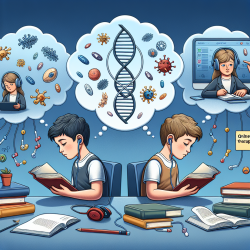Introduction
In the pursuit of excellence in speech-language pathology, practitioners are continually seeking new insights and methodologies that can enhance therapeutic outcomes. While the connection between the molecular diet analysis of Anguilliformes leptocephalus larvae and speech-language pathology might not be immediately apparent, the principles of data-driven decision-making and innovative research techniques are universally applicable. This blog explores how the recent study on leptocephalus larvae can inspire speech-language pathologists to refine their practices and encourage further research.
Understanding the Study
The research article titled "Molecular diet analysis of Anguilliformes leptocephalus larvae collected in the western North Pacific" employs advanced metagenomic analysis to unravel the dietary habits of these enigmatic larvae. By analyzing DNA samples from both the gut contents and body surface of leptocephali, the study provides insights into the diverse eukaryotic groups present in their diet. Notably, the study highlights the prevalence of cnidarian DNA, suggesting potential cross-contamination from the environment, and supports the hypothesis that leptocephali utilize detritus materials, commonly known as marine snow.
Lessons for Speech-Language Pathologists
While the focus of the study is marine biology, the methodologies and analytical techniques employed offer valuable lessons for speech-language pathologists:
- Embrace Data-Driven Decisions: Just as the researchers used molecular analysis to gain insights into the larvae's diet, speech-language pathologists can utilize data-driven approaches to tailor therapy interventions. By systematically collecting and analyzing data on children's progress, practitioners can make informed decisions that optimize therapeutic outcomes.
- Innovative Research Techniques: The use of next-generation sequencing (NGS) in the study exemplifies the power of cutting-edge technology in research. Speech-language pathologists can similarly explore innovative tools and techniques, such as eye-tracking or neuroimaging, to gain deeper insights into speech and language development.
- Cross-Disciplinary Inspiration: The study's findings on cross-contamination highlight the importance of considering external factors that may influence outcomes. In speech-language pathology, understanding the broader context of a child's environment, including family dynamics and educational settings, can provide a more comprehensive approach to therapy.
Encouraging Further Research
The study's findings open avenues for further exploration in both marine biology and speech-language pathology. For practitioners in the field, this research serves as a reminder of the importance of continual learning and adaptation. By staying informed about the latest research across disciplines, speech-language pathologists can enhance their practice and contribute to the growing body of knowledge.
To read the original research paper, please follow this link: Molecular diet analysis of Anguilliformes leptocephalus larvae collected in the western North Pacific.










